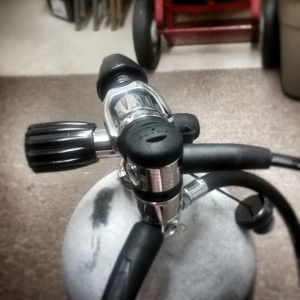 Are all regulators created equal? What's the difference between "balanced" and "over-balanced" regulators and diaphragm vs. piston regulators? With so many options laid out before you in your dive shop's display case, how do you know which one is right for you?
Are all regulators created equal? What's the difference between "balanced" and "over-balanced" regulators and diaphragm vs. piston regulators? With so many options laid out before you in your dive shop's display case, how do you know which one is right for you?
Walk into your nearest dive store and you will most likely see an overwhelming assortment of scuba regulators. As a new, or even seasoned diver, you may be wondering how can these regulators vary in price from $150 to over $1000!? Are they really all that different? The sales associate may give you the regulator low down that contains lots of technical terms like "piston," "diaphragm," "pneumatically balanced," "Venturi valve," etc. and you may have no idea what they are talking about. We are going to help you out by breaking down all of the technical jargon.
However, in part one of this two part series, let's review the basic functioning of a scuba regulator. In your Open Water Course you may have gotten the quick run through of how your regulator works and the different parts of the regulator, but you also learned a gazillion other things at the same time. What you may recall is that a scuba regulator is made up of two main parts, the first stage and the second stage; the first stage hooks on to your tank and the second stage goes in your mouth. So, before we get into the specifics of all the different types of regulators there are and all the features you will have to choose from (we'll get into all of those in "Part 2" of this blog post) let's explore the details of how a regulator works in some non-technical terms.
Regulators are designed to deliver air on demand to the diver, automatically adjusting to increasing pressure. As the diver inhales, the air from the tank is allowed to flow to the diver.
The Regulator's First Stage
The First Stage of the regulator is the part that hooks on to your scuba tank. It's primary purpose is to reduce the pressure from what is currently in your cylinder to an intermediate pressure (IP) that can feed air to not only your Second Stage (the part of the regulator you breath from) but also your low-pressure inflator, octopus, gauges and air-integrated computer. The job of the first stage is to keep that intermediate pressure as consistent as possible throughout the dive as you ascend, descend, and as the pressure inside of the cylinder decreases.
The Regulator's Second Stage
 The second stage of a regulator is the part of the regulator that you hold in your mouth and from which you breath. Its main job is to basically take the air from the first stage that has been reduced to the intermediate "usable" pressure, and then further reduce the air pressure to a pressure that is comfortable to breath. This is called "ambient pressure." A hose that is attached to the first stage delivers air through a small valve on the second stage. A diaphragm inside of the second stage responds to your breathing and is what activates the valve to open and close. As you inhale, the diaphragm opens the valve automatically and allows the air to flow into the second stage. When inhalation stops, the diaphragm returns to the closed position, stopping the flow of air.
The second stage of a regulator is the part of the regulator that you hold in your mouth and from which you breath. Its main job is to basically take the air from the first stage that has been reduced to the intermediate "usable" pressure, and then further reduce the air pressure to a pressure that is comfortable to breath. This is called "ambient pressure." A hose that is attached to the first stage delivers air through a small valve on the second stage. A diaphragm inside of the second stage responds to your breathing and is what activates the valve to open and close. As you inhale, the diaphragm opens the valve automatically and allows the air to flow into the second stage. When inhalation stops, the diaphragm returns to the closed position, stopping the flow of air.
Functioning of a Regulator's Second Stage
https://www.youtube.com/watch?v=mnd-nhmgHaM
Now that you know the basic functioning of a scuba regulator you are ready to learn all of the technical terms your local dive store sales associate will use when selling you a regulator. So, stay tuned for next week's blog to learn these important terms before you decide on which is the right regulator for you!






